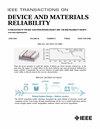一种新型单事件抗辐照SOI沟栅灯
IF 2.3
3区 工程技术
Q2 ENGINEERING, ELECTRICAL & ELECTRONIC
IEEE Transactions on Device and Materials Reliability
Pub Date : 2025-07-21
DOI:10.1109/TDMR.2025.3590736
引用次数: 0
摘要
为了缓解沟槽栅极周围的电流集中,从而抑制单事件烧毁(SEB),减小栅极氧化物处的最大电场,从而降低单事件栅极破裂(SEGR)的风险,提出了一种带额外空穴路径的沟槽栅极侧绝缘栅极双极晶体管(HP light)。采用点阵加热模型,通过TCAD模拟研究了沟槽栅光器件与沟槽栅横向扩散金属氧化物半导体(LDMOS)的SEB位置,前者在沟槽栅附近失效,后者在漏极接触处失效。发现在发射极或源侧附近的n漂区是诱导SEB最敏感的位置。仿真结果表明,对于具有高线性能量传递(LET)值的离子,HP light的触发SEB的阈值电压为76.56 MeV $\cdot $ cm2/mg,比传统light的阈值电压高46%。此外,HP light的栅极氧化物处的最大电场比传统light低55%。本文章由计算机程序翻译,如有差异,请以英文原文为准。
A Novel Single Event Irradiation-Hardened SOI Trench Gate LIGBT
A trench gate lateral insulated gate bipolar transistor with an extra hole path (HP LIGBT) is proposed to ease the current concentration around the trench gate so as to suppress single-event burnout (SEB) and reduce the maximum electric field at the gate oxide so as to lower the risk of single-event gate rupture (SEGR). The SEB position of the trench gate LIGBT in comparison with the trench gate laterally diffused metal-oxide semiconductor (LDMOS) is studied by TCAD simulations with lattice heating model, where the former fails around the trench gate but the latter fails at the drain contact. The most sensitive position for inducing SEB is found to be both at the n-drift region near the emitter or source side. Simulation results show that the threshold voltage of triggering SEB of the HP LIGBT for ion species with high linear energy transfer (LET) values of 76.56 MeV $\cdot $ cm2/mg can be 46% higher than that of the conventional LIGBT. Moreover, the maximum electric field at the gate oxide of HP LIGBT is 55% lower than the conventional LIGBT.
求助全文
通过发布文献求助,成功后即可免费获取论文全文。
去求助
来源期刊

IEEE Transactions on Device and Materials Reliability
工程技术-工程:电子与电气
CiteScore
4.80
自引率
5.00%
发文量
71
审稿时长
6-12 weeks
期刊介绍:
The scope of the publication includes, but is not limited to Reliability of: Devices, Materials, Processes, Interfaces, Integrated Microsystems (including MEMS & Sensors), Transistors, Technology (CMOS, BiCMOS, etc.), Integrated Circuits (IC, SSI, MSI, LSI, ULSI, ELSI, etc.), Thin Film Transistor Applications. The measurement and understanding of the reliability of such entities at each phase, from the concept stage through research and development and into manufacturing scale-up, provides the overall database on the reliability of the devices, materials, processes, package and other necessities for the successful introduction of a product to market. This reliability database is the foundation for a quality product, which meets customer expectation. A product so developed has high reliability. High quality will be achieved because product weaknesses will have been found (root cause analysis) and designed out of the final product. This process of ever increasing reliability and quality will result in a superior product. In the end, reliability and quality are not one thing; but in a sense everything, which can be or has to be done to guarantee that the product successfully performs in the field under customer conditions. Our goal is to capture these advances. An additional objective is to focus cross fertilized communication in the state of the art of reliability of electronic materials and devices and provide fundamental understanding of basic phenomena that affect reliability. In addition, the publication is a forum for interdisciplinary studies on reliability. An overall goal is to provide leading edge/state of the art information, which is critically relevant to the creation of reliable products.
 求助内容:
求助内容: 应助结果提醒方式:
应助结果提醒方式:


